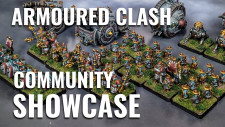
HMS Gaming Table
3. - Whip dat Mainframe, I'll explain
No, I am not finishing the lyric off.
With the legs now complete I could start building the frame on top. This wasn’t a particularly complex task, the wood comes in 2440mm lengths and is pre sanded. Therefore it requires relatively little work, just a tiny bit of sanding at the ends. The frame was constructed by attaching the edge pieces first – that is the two end leg frames and the two long edge beams. This creates a nice rectangular frame. After that I added two more beams running the length of the table Which would ensure that the gaming surface was supported across its entire width. We found gamers tend to lean into the middle of the table to move models and then put their weight onto the table and so the surface needed to be protected from bending both at the edge, where players will invariably casually lean between turns, and in the middle where they lean during their turn. Requesting people not lean on the table hasn’t worked. Once all four beams were attached the remaining leg frames were attached, using the flat plywood sheets to get the spacing correct. The result of this process reminded me of the build process for old wooden sailing ships or viking longships – a bare wooden frame waiting for some panelling to make it useful.
The top frame is made from 69mm x 24mm sanded timber.











































































Leave a Reply